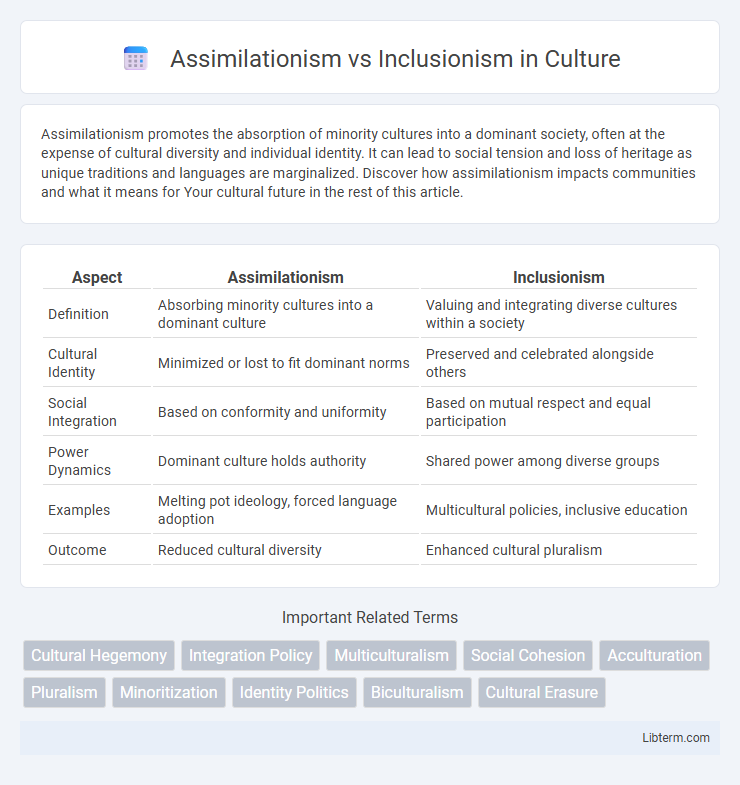Assimilationism promotes the absorption of minority cultures into a dominant society, often at the expense of cultural diversity and individual identity. It can lead to social tension and loss of heritage as unique traditions and languages are marginalized. Discover how assimilationism impacts communities and what it means for Your cultural future in the rest of this article.
Table of Comparison
| Aspect | Assimilationism | Inclusionism |
|---|---|---|
| Definition | Absorbing minority cultures into a dominant culture | Valuing and integrating diverse cultures within a society |
| Cultural Identity | Minimized or lost to fit dominant norms | Preserved and celebrated alongside others |
| Social Integration | Based on conformity and uniformity | Based on mutual respect and equal participation |
| Power Dynamics | Dominant culture holds authority | Shared power among diverse groups |
| Examples | Melting pot ideology, forced language adoption | Multicultural policies, inclusive education |
| Outcome | Reduced cultural diversity | Enhanced cultural pluralism |
Understanding Assimilationism
Assimilationism centers on integrating individuals into a dominant culture by encouraging conformity to its norms, values, and practices, often at the expense of preserving distinct cultural identities. This approach assumes that social cohesion and unity are achieved through cultural homogeneity, promoting a singular national identity. Critics argue that Assimilationism can marginalize minority groups by disregarding diversity and limiting multicultural expression.
Defining Inclusionism
Inclusionism emphasizes embracing diversity by integrating individuals from various backgrounds without requiring them to abandon their unique cultural identities. This approach promotes equal participation and representation within organizations and societies, fostering environments where differences are respected and valued. Inclusionism contrasts with assimilationism by prioritizing adaptability and mutual understanding over conformity to a dominant culture.
Historical Context of Both Concepts
Assimilationism, rooted in 19th and early 20th-century nation-building efforts, emphasized the absorption of minority groups into a dominant culture, often promoting uniformity in language, customs, and values to forge social cohesion. Inclusionism emerged later, particularly post-1960s civil rights movements, advocating for the recognition and respect of cultural diversity within societies, supporting pluralism and equal participation without erasing distinct identities. The historical context reveals assimilationism's alignment with centralized state power and homogenization, while inclusionism corresponds to democratic values and multicultural policies promoting social equity.
Core Principles of Assimilationism
Assimilationism emphasizes the absorption of minority groups into the dominant culture, prioritizing uniformity and the reduction of cultural diversity within a society. Core principles include the expectation that individuals adopt the language, customs, and values of the majority to achieve social cohesion and national unity. This approach often downplays cultural differences, aiming for a single, homogeneous national identity.
Key Tenets of Inclusionism
Inclusionism emphasizes embracing diversity by ensuring equitable participation and respect for all cultural identities within a society. It advocates for systemic changes that remove barriers to inclusion, promoting representation and validation of marginalized groups. Policies under inclusionism focus on creating environments where differences are not only accepted but actively valued for their contributions to social cohesion and innovation.
Cultural Identity: Loss vs Preservation
Assimilationism often leads to the loss of cultural identity by encouraging minority groups to conform to the dominant culture's norms and values, resulting in diminished linguistic, religious, and traditional practices. Inclusionism prioritizes the preservation of cultural identity by fostering environments where diverse cultural expressions are recognized, respected, and maintained within the broader society. Research shows that inclusionist approaches enhance social cohesion and individual well-being by empowering marginalized communities to retain their unique heritage while participating fully in societal life.
Social Implications and Outcomes
Assimilationism promotes the absorption of minority groups into the dominant culture, often leading to the loss of cultural identity and social homogenization, which can result in marginalization and reduced social cohesion. Inclusionism advocates for the recognition and accommodation of diverse cultural backgrounds, fostering social integration, equal participation, and enhanced mutual respect among different groups. Research shows that inclusionist policies contribute to higher levels of social capital and reduce systemic inequalities compared to assimilationist approaches.
Policy Approaches: Assimilationism vs Inclusionism
Assimilationism policy approaches emphasize conforming minority groups to the dominant culture, often promoting uniformity in language, values, and social norms. Inclusionism policies prioritize diversity and equal participation, encouraging the recognition and integration of different cultural identities within societal institutions. These differing strategies impact educational curricula, workplace diversity initiatives, and legal frameworks addressing minority rights.
Case Studies and Real-World Examples
Assimilationism often appears in case studies where minority groups are pressured to conform to dominant cultural norms, such as Native American boarding schools in the 19th and 20th centuries, which aimed to erase indigenous identities. Inclusionism is exemplified by contemporary educational systems embracing multicultural curricula, like Canada's policy promoting diversity and equity in schools to support students' varied cultural backgrounds. Real-world examples show that inclusionism fosters social cohesion and respect for diversity, while assimilationism frequently results in loss of cultural heritage and social marginalization.
Future Directions in Diversity Management
Future directions in diversity management emphasize shifting from assimilationism, which pressures conformity, to inclusionism that values authentic individual identities within organizations. Embracing inclusionism enhances innovation and employee engagement by fostering environments where diverse perspectives are integrated and valued. Strategies focus on continuous learning, equitable policies, and technology-driven analytics to measure and improve inclusion outcomes effectively.
Assimilationism Infographic

 libterm.com
libterm.com